
HYDROMETALLURGY
Scope & Guideline
Unlocking the potential of materials chemistry for a sustainable world.
Introduction
Aims and Scopes
- Metal Recovery Techniques:
Research primarily involves the development and optimization of methods for recovering metals such as lithium, cobalt, nickel, and rare earth elements from various ores and waste materials. - Environmental Sustainability:
A significant focus is placed on environmentally friendly processes, including bioleaching and the use of green solvents, to minimize ecological impacts during metal extraction. - Process Optimization and Modeling:
The journal highlights studies on the optimization of extraction processes through modeling and experimental approaches, including kinetic studies and thermodynamic assessments. - Innovative Materials and Technologies:
Exploration of novel materials, such as ionic liquids and deep eutectic solvents, for improved metal extraction efficiency and selectivity. - Waste Management:
Research includes methods for the recovery of valuable metals from waste products, such as electronic waste and industrial by-products, promoting a circular economy. - Characterization Techniques:
The journal emphasizes the use of advanced characterization techniques to understand the mechanisms of metal recovery and the properties of leachates.
Trending and Emerging
- Biohydrometallurgy:
Research in bioleaching and other biotechnological approaches for metal recovery is gaining traction, focusing on the use of microorganisms to enhance extraction processes. - Circular Economy Practices:
There is a growing emphasis on recycling and recovery of metals from waste materials, aligning with global sustainability goals and the circular economy paradigm. - Ionic Liquids and Deep Eutectic Solvents:
The application of ionic liquids and deep eutectic solvents for metal extraction is emerging as a significant area of interest, offering cleaner alternatives to conventional solvents. - Integrated Process Design:
Research is increasingly focusing on the integration of various extraction methods and technologies to improve overall efficiency and sustainability in hydrometallurgical processes. - Advanced Characterization Techniques:
The use of advanced characterization methods, including molecular dynamics simulations and spectroscopic techniques, is becoming more prevalent to better understand extraction mechanisms. - Waste Valorization:
Emerging studies are focusing on the valorization of industrial and mining wastes, transforming them into valuable resources through innovative hydrometallurgical approaches.
Declining or Waning
- Conventional Solvent Extraction:
While still relevant, traditional solvent extraction processes are being overshadowed by more environmentally friendly and efficient methods, such as bioleaching and the use of ionic liquids. - High-Temperature Pyrometallurgical Processes:
There is a noticeable decrease in research focused on high-temperature pyrometallurgical methods as the industry shifts towards lower-energy and more sustainable extraction techniques. - Single-Metal Extraction Techniques:
Research on methods targeting the extraction of single metals is declining in favor of integrated approaches that recover multiple metals simultaneously from complex waste streams. - Basic Kinetic Studies:
Basic kinetic studies without innovative applications are becoming less common, with a shift towards more applied research that integrates kinetics with process optimization in real-world scenarios.
Similar Journals
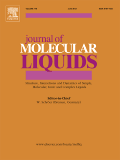
JOURNAL OF MOLECULAR LIQUIDS
Exploring the Depths of Molecular InteractionsJOURNAL OF MOLECULAR LIQUIDS, published by Elsevier, is a premier academic journal focused on the intricate nature of molecular liquids, spanning foundational to applied research. With an ISSN of 0167-7322 and an E-ISSN of 1873-3166, this journal has established its significance in various fields, achieving Q1 rankings across atomic and molecular physics, condensed matter physics, and materials chemistry, among others, as of 2023. The journal’s broad scope, covering studies from theoretical frameworks to experimental applications, serves as a vital platform for disseminating innovative research findings while advancing our understanding of molecular interactions and dynamics. With a strong position in Scopus rankings and high impact factors, it is a trusted resource for researchers, professionals, and students alike, seeking comprehensive insights into molecular liquids. As a journal that thrives on pioneering energy, the JOURNAL OF MOLECULAR LIQUIDS is essential for anyone wishing to remain at the forefront of research in this dynamic field.
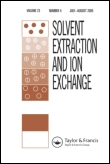
SOLVENT EXTRACTION AND ION EXCHANGE
Pioneering Research in Solvent Extraction and Ion ExchangeSOLVENT EXTRACTION AND ION EXCHANGE is a prominent academic journal dedicated to the field of Chemical Engineering and Chemistry, published by Taylor & Francis Inc. With its ISSN 0736-6299 and E-ISSN 1532-2262, the journal serves as a vital resource for researchers and practitioners seeking to advance their understanding and application of solvent extraction and ion exchange methodologies. Recognized for its impact, the journal holds respectable rankings, placed in Q2 for Chemical Engineering and Q3 for Chemistry as of 2023, reflecting its significant contribution to the academic community. The journal covers a wide range of topics from fundamental studies to innovative applications, enhancing both theoretical perspectives and practical implementations. With a robust readership spanning across the globe, SOLVENT EXTRACTION AND ION EXCHANGE not only facilitates the dissemination of critical research findings but also encourages interdisciplinary collaboration and knowledge sharing among scientists, engineers, and students alike. Researchers are invited to contribute to this esteemed journal, which works to illuminate the evolving landscape of chemical processing and separation technologies.
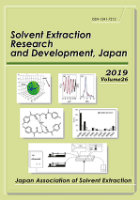
SOLVENT EXTRACTION RESEARCH AND DEVELOPMENT-JAPAN
Advancing solvent extraction for a sustainable future.SOLVENT EXTRACTION RESEARCH AND DEVELOPMENT-JAPAN is a prominent journal dedicated to advancing the field of solvent extraction and its applications in chemical engineering and general chemistry. Published by the Japan Association for Solvent Extraction, this journal plays a crucial role in disseminating innovative research findings, technical advancements, and comprehensive reviews pertinent to solvent extraction processes and technologies. With a publication history dating back to 1996 and extending through 2024, it serves as a vital resource for academics, industry professionals, and students alike. Although it currently does not offer open access, the journal provides invaluable insights into solvent extraction which can enhance both theoretical knowledge and practical applications in various industries. Its Scopus rankings indicate a competitive presence in the field, making it an essential read for anyone engaged in chemical engineering research. The journal is accessible via its office located at Professor Kenichi Akiba's residence at the University of Kitakyushu, and it invites contributions from researchers aiming to elevate the understanding and efficiency of solvent-based methodologies in chemical processes.

Advances in Sample Preparation
Empowering Scientists to Perfect Sample PreparationAdvances in Sample Preparation is a leading open-access journal published by Elsevier, that has rapidly become a significant platform for disseminating research in the field of sample preparation techniques, contributing to the wider disciplines of Chemistry and Environmental Chemistry. Since its inception in 2022, the journal has established itself with a notable impact factor, ranking Q2 in miscellaneous Chemistry and Q3 in Environmental Chemistry for 2023, reflecting its commitment to high-quality publications. With an E-ISSN of 2772-5820, it is dedicated to providing a forum for researchers, professionals, and students to share novel methodologies, innovative protocols, and advances in preparation techniques that enhance the accuracy and efficiency of experimental analyses. This journal not only supports the academic community but also promotes the open exchange of knowledge, fostering collaboration among scientists globally. Be part of this dynamic conversation as it evolves and contributes to significant advancements in sample preparation methodologies.
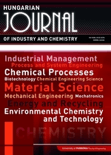
Hungarian Journal of Industry and Chemistry
Pioneering Research for Tomorrow's Chemical IndustryHungarian Journal of Industry and Chemistry, published by UNIV PANNONIA, has long been a cornerstone in the fields of industrial and chemical research since its inception in 1974. With a focus on integrating innovative studies and applications within the chemical industry, this journal serves as a vital platform for researchers and practitioners aiming to disseminate their findings and advancements in both theoretical and practical domains. Although its coverage in Scopus has been discontinued post-2002, it continues to be an essential resource for students and professionals seeking insights into the transformative practices and developments in chemistry and industry. The journal's commitment to fostering academic discourse is reflected in its compelling array of articles, making it indispensable for anyone engaged in the evolving landscape of industrial chemistry.

MICROCHEMICAL JOURNAL
Connecting Researchers Through Groundbreaking Microchemical StudiesMicrochemical Journal, published by Elsevier, stands as a leading scholarly publication in the fields of Analytical Chemistry and Spectroscopy, boasting impressive rankings of Q1 and Q2 in their respective categories for 2023. With an H-index reflecting its substantial impact and relevance, this journal has been a cornerstone of research dissemination since its inception in 1957, and it continues to play a vital role in advancing the methodological and technological innovations within these disciplines. The journal presents peer-reviewed articles that explore a wide array of topics, making it an essential resource for researchers, professionals, and students keen on the latest advancements in microchemical processes and techniques. Although it does not currently offer open access options, its publication through Elsevier ensures a high standard of academic integrity and wide accessibility through various academic institutions. With a strong Scopus ranking—9th in Chemistry Spectroscopy and 22nd in Analytical Chemistry—Microchemical Journal is an indispensable platform for empirical studies, insightful reviews, and pioneering methodologies in the microchemical domain.
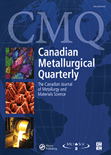
CANADIAN METALLURGICAL QUARTERLY
Unveiling Breakthroughs in Metals and Alloys.Canadian Metallurgical Quarterly is a prestigious scholarly journal published by Taylor & Francis Ltd, dedicated to the field of metallurgical engineering and materials science. With a rich history dating back to its inception in 1962 and continuing through its most recent publications, this journal serves as a vital platform for the dissemination of innovative research, advancements, and critical reviews in metallurgy, metals, and alloys. Positioned strategically within the academic community, it holds a significant impact factor and is currently rated in the Q2 category for Metals and Alloys, and Q3 in Industrial and Manufacturing Engineering as of 2023, showcasing its authoritative role in these disciplines. Although it does not offer open access, the journal remains widely recognized for its rigorous peer-review process, ensuring that published work adheres to the highest standards of scientific quality. Researchers, professionals, and students alike will find invaluable insights and contributions that drive the field forward.
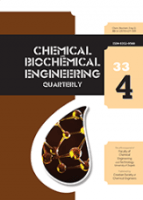
CHEMICAL AND BIOCHEMICAL ENGINEERING QUARTERLY
Bridging Academia and Industry in Chemical InnovationsCHEMICAL AND BIOCHEMICAL ENGINEERING QUARTERLY, published by the Croatian Society of Chemical Engineering Technology, is a distinguished open-access journal that has been providing a platform for the dissemination of innovative research since its inception in 1987. With a focus on the fields of biochemistry and chemical engineering, this quarterly journal addresses a wide array of topics, including process chemistry and technology, making significant contributions to both academia and industry. Despite its current positioning in the Q4 category for biochemistry and Q3 for miscellaneous chemistry and process chemistry in 2023, the journal continues to strive for greater impact, catering to researchers, professionals, and students alike. Its open-access model, in place since 2001, ensures that cutting-edge research is accessible to a broad audience, fostering collaboration and knowledge sharing within the scientific community. By promoting high-quality research and providing insights into the latest advancements, Chemical and Biochemical Engineering Quarterly remains an essential resource for those involved in the chemical and biochemical engineering disciplines.

JOURNAL OF CHEMICAL AND ENGINEERING DATA
Advancing Knowledge in Chemical Engineering and Data ScienceThe Journal of Chemical and Engineering Data (ISSN: 0021-9568, E-ISSN: 1520-5134) is a prestigious publication by the American Chemical Society, dedicated to disseminating high-quality research within the fields of chemical engineering and chemistry. With its history dating back to 1956, the journal has evolved to encompass a wide array of topics essential to the advancement of both disciplines, reaching an impressive convergence year of 2024. Positioned in the Q2 quartile for both Chemical Engineering and Chemistry, it boasts a commendable ranking of 95th out of 273 in General Chemical Engineering and 146th out of 408 in General Chemistry, reinforcing its significance within the academic community. As a vital resource for researchers, professionals, and students alike, the journal encourages rigorous submissions that contribute to the understanding and application of chemical and engineering data, despite its traditional access model. By bridging theoretical insights with practical applications, the Journal of Chemical and Engineering Data remains an indispensable tool for those seeking to drive innovation and efficiency in the chemical sciences.

Current Green Chemistry
Unveiling the future of chemistry with eco-friendly insights.Current Green Chemistry, published by Bentham Science Publishers, is a pivotal scholarly resource devoted to advancing the field of green chemistry. With ISSN 2213-3461 and E-ISSN 2213-347X, this journal serves as a crucial platform for researchers and professionals to explore innovative and sustainable practices within the chemical sciences. The journal has demonstrated significant recognition, evidenced by its categorization in the third quartile (Q3) across various specializations including Analytical Chemistry and Inorganic Chemistry, and even a fourth quartile (Q4) in Organic Chemistry, according to the latest Scopus metrics. This indicates a growing influence in relevant fields, making it a valuable reference for contemporary environmental initiatives. The journal's accessible nature, although not open access, ensures researchers can still engage with high-quality, peer-reviewed content. Spanning an impressive converged period from 2019 to 2024, Current Green Chemistry is committed to enhancing the visibility of groundbreaking research that aligns with sustainable development objectives, making it an essential resource for anyone interested in the future of chemistry.